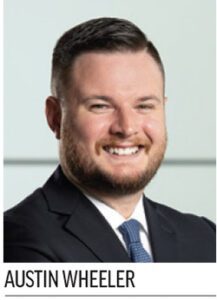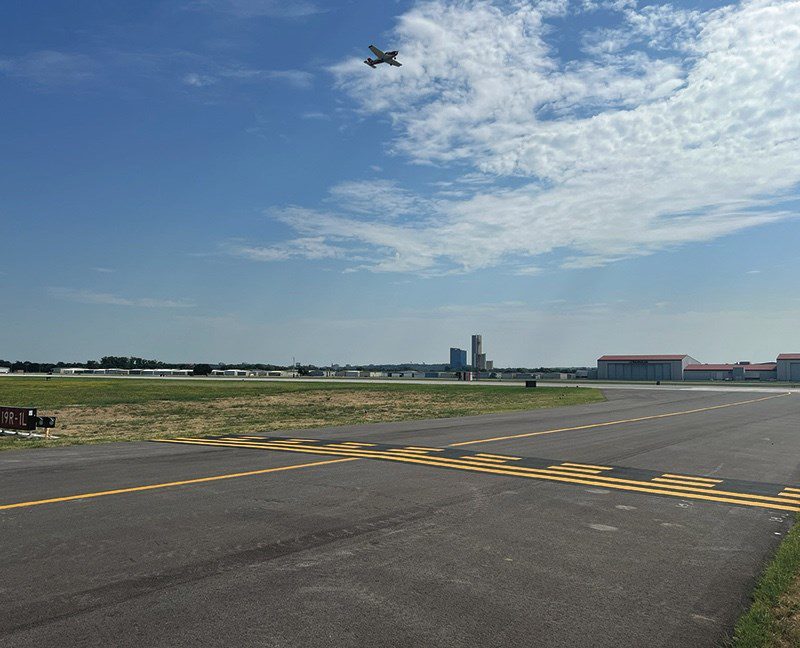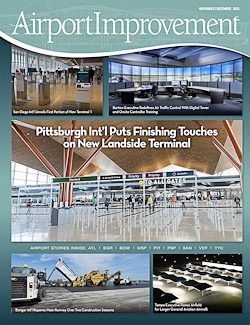“Building the plane while flying it” is a colorful sentiment that describes creating a plan while a project is already underway, or starting a complicated new endeavor in the midst of another. Pilots are thankful it is strictly a metaphor, but airport managers aren’t so lucky. They often need to build or renovate while also keeping their existing facilities operational.
Austin Wheeler, manager of Tulsa Riverside Airport (RVS), knows that feeling well. He recently oversaw the realignment, reconstruction and rehabilitation of four connector taxiways at the busy general aviation airfield in northeast Oklahoma. To minimize disruptions for RVS tenants and users, the project team devised a detailed project strategy—the exact opposite of building a plane while flying it.
“Planning ahead goes a long way,” says Wheeler. “Knowing what the game plan is and communicating that to our tenants and users really made things go smoothly.”
| facts&figures
Project: Taxiway Realignment Location: Ancillary Work: LED taxiway lights & signage; new direct access control markings; removed section of pavement & replaced with sod Total Cost: $7.6 million Funding: $6.85 million FAA grant; $381,000 OK Dept. of Aerospace & Aeronautics grant; $423,928 Tulsa Airports Improvement Trust grant Construction: Engineering Consultant: Olsson Airfield Paving, Lighting, Drainage, Geotechnical, Construction Materials Testing: Olsson Airport Master Plan Consultant: RS&H Prime Contractor: Airfield Lighting & Signing: Libra Electric Lighting Supplier: Safety & Phasing Devices; Pavement Markings: Sodding & Erosion Control: Verdigris Valley Sod Farms Geotextile Supplier: ALCMS Update: ADB SAFEGATE |
The team scheduled the airfield work in two phases, and each was broken into five sub-phases. “We planned ahead to get as much work as possible completed outside of the runway safety area,” Wheeler explains. “When we did need to get inside the runway safety area, we had everything ready to go; so we kept runways closed for a minimum amount of time.”
What Changed
The $7.6 million project removed older, various-angled taxiways and replaced them with new taxiways that meet the airport’s runways at right angles and adhere to current FAA design standards. The first phase of the project consisted of rehabilitating one connector taxiway and reconstructing three others, all north of the airport’s crosswind runway. That work was initiated and completed in spring 2023.
During the second phase, crews removed two high-speed taxiways south of the crosswind runway and constructed three new right-angle taxiways. Contractors also removed a large triangular area of unused, deteriorating pavement and replaced it with sod. The second phase was initiated in early spring of this year and completed in May.
The new right-angle turnoffs are designed to help prevent faster moving traffic from inadvertently rolling onto the apron—an important improvement because the apron is close to the main runway, 1L-19R.
“The configuration of our runway to the taxiway and to our parking ramp is tight,” Wheeler explains. “Having aircraft slow down for the 90-degree turns ensures they are traveling at an appropriate speed leading into that parking area.”
Because the project brings the airfield geometry in line with current FAA standards and enhances safety for pilots, it was eligible for $6.85 million in FAA grants. Oklahoma Department of Aerospace & Aeronautics (ODAA) contributed about $381,000; and Tulsa Airports Improvement Trust (TAIT), which administers, manages and operates RVS and Tulsa International Airport, contributed $423,928.
Minimizing Downtime
Operating as a general aviation airport since 1958, RVS does not have commercial airline flights. Its traffic comes from five flight schools, a steady stream of business jets and miscellaneous general aviation activity. Wheeler notes that updating the airfield’s taxiway configurations was especially important to the flight schools, because thousands of pilots who train there every year need to practice on an airfield with standard design parameters. Now, the taxiways at RVS will prepare students for what they’ll encounter at most other U.S. airports.
Even without scheduled commercial service, RVS logs about 243,000 aircraft operations per year, making it the busiest airport in Oklahoma and one of the 50 busiest airports in the United States (based on 2023 figures). The airfield is populated with more than 200 commercial and private hangars for upwards of 500 based aircraft.
Given its active traffic profile, the airport worked with Olsson, an engineering and design firm, to develop a project strategy that minimized the amount of time the primary runway would need to close for taxiway work. In total, Runway 1L-19R was effectively closed for a combined five months during both phases of the project.
Throughout the work, flight school airplanes were still able to take off and land at RVS on the shorter parallel runway, 1R-19L. However, they were diverted to nearby airports such as Okmulgee Regional and Sand Springs Pogue Airport for touch-and-to practice. Larger business jets that needed the full length of RVS’ 5,102-foot primary runway temporarily operated out of Tulsa International Airport while 1L-19R was closed. And the team at RVS sent weekly construction updates to all tenants.

Crews removed the old Taxiway A2, and a new one was installed about 1,200 feet to the south.
“When you close the runway for five months, there are going to be pains,” Wheeler acknowledges. “We feel that, too. It reduces our operational count, which is a badge we wear with a lot of pride. Even with the closure, we were able to be top five in the Southwest Region, so we’re really excited to see what we can be with the airfield open all year.”
 Brian Coomes, lead engineer at Olsson, credits Wheeler’s team for relaying updates to airport tenants and other key stakeholders. “It takes good partners all the way around for good communication,” says Coomes.
Brian Coomes, lead engineer at Olsson, credits Wheeler’s team for relaying updates to airport tenants and other key stakeholders. “It takes good partners all the way around for good communication,” says Coomes.
Throughout the project, Olsson held weekly progress meetings with the engineering team, contractor and airport staff. “We talked about current problems, schedule updates, any coordination needed,” says Coomes. “That really facilitated a lot of partnering along the way.”
Crews encountered weather-related delays during the first phase of the project but worked some Saturdays to make up for the lost time and even get ahead of schedule. “Oklahoma weather can be unpredictable, so we carried that lesson into the second phase,” Wheeler notes. “We ended up with only two weather delays on that portion, so we came out ahead of the curve.”
 More Improvements
More Improvements
In addition to reconfiguring its taxiway geometry, RVS also installed new taxiway edge lighting and new signage. Another step to enhance airfield safety involved adding pavement markings to the three newly constructed taxiways that connect directly to the main aircraft parking apron. Painting “No Taxi Islands” on the apron where it intersects with the new taxiways helps minimize the potential for pilots to be confused about their location and drive onto the runway thinking they are still on a taxiway, Wheeler explains. Pavement markings guide pilots to take a series of right-angle turns as they approach the runway from the apron.
Later this year, RVS will begin the design process for a project to widen its crosswind runway. Construction is expected to start in late 2025 or early 2026, with an estimated budget of $1.6 million.
“There’s always some project going on,” Wheeler says.



